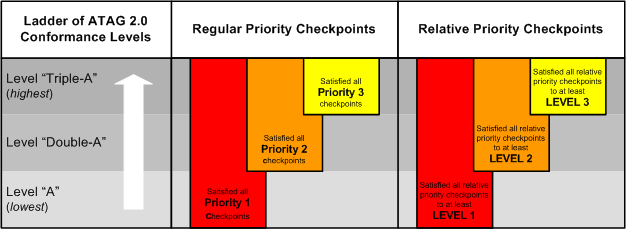3. Conformance
3.1 Conformance Scheme
"ATAG 2.0" allows authoring tools to claim conformance to one of three conformance levels depending on the priority of the checkpoints that the authoring tool has satisfied.
3.1.1 Conformance Levels
- Level "A"
- The authoring tool has satisfied all Priority 1 regular poriority checkpoints and has also satisfied all of the relative priority checkpoints to at least Level 1.
- Level "Double-A"
- The authoring tool has satisfied all Priority 1 and Priority 2 regular poriority checkpoints and has also satisfied all of the relative priority checkpoints to at least Level 2.
- Level "Triple-A"
- The authoring tool has satisfied all Priority 1, Priority 2, and Priority 3 regular poriority checkpoints and has also satisfied all of the relative priority checkpoints to at least Level 3.
Figure 1: A graphical view of the requirements of the ATAG 2.0 Conformance Levels (described above).
Long Description (to be hidden later): A graphic that illustrates the levels of conformance as they are explained in the text of the conformance level section. The graphic is a table with three columns and four rows. The header row labels are "Ladder of ATAG 2.0 Conformance Levels", "Regular Priority Checkpoints" and "Relative Priority Checkpoints". The other rows are labeled "Level 'Triple-A' (highest) ", "Level 'Double-A'", and "Level 'A' (lowest) ". Bar charts super-imposed on the rows demonstrate that in order to meet each higher level, additional regular priority checkpoints must be met as well as increasing levels of relative priority checkpoints.
3.1.2 Checkpoint Priorities
Each checkpoint has been assigned a priority level that indicates the importance of the checkpoint in satisfying the guideline under which the checkpoint appears. The priority of a checkpoint determines whether that checkpoint must be met in order for an authoring tool to achieve a particular conformance level. There are three levels of regular priority checkpoints as well as a special class of relative priority checkpoints that rely on WCAG as a benchmark for determining accessibility.
Regular Priority Checkpoints:
- Priority 1
- Indicates that if the authoring tool does not satisfy these checkpoints, one or more groups of authors with disabilities will find it impossible to author for the Web (for Guideline 1 checkpoints) or that these checkpoints are essential for any authors using the authoring tool to create Web content that conforms to WCAG (for Guideline 2, 3, 4 checkpoints).
- Priority 2
- Indicates that if the authoring tool does not satisfy these checkpoints, one or more groups of authors with disabilities will find it difficult to author for the Web (for Guideline 1 checkpoints) or that these checkpoints are important for any authors using the authoring tool to create Web content that conforms to WCAG (for Guideline 2, 3, 4 checkpoints).
- Priority 3
- Indicates that if the authoring tool does not satisfy these checkpoints, one or more groups of authors with disabilities will find it inefficient to author for the Web (for Guideline 1 checkpoints) or that these checkpoints are beneficial for any authors using the authoring tool to create Web content that conforms to WCAG (for Guideline 2, 3, 4 checkpoints).
Relative Priority Checkpoints
The importance of the relative checkpoints depends on the requirements defined by whichever version of WCAG the evaluator has defined in the conformance profile. These checkpoints can be met to one of three levels:
- Level 1
- Web content conforms to either WCAG 1.0 Level "A" or WCAG 2.0 Level "A". Indicates that the WCAG benchmark for Web content in the authoring interface (for Guideline 1 checkpoints) or produced by the tool (for Guideline 2, 3, 4 checkpoints) is set at the minimum conformance level.
- Level 2
- Web content conforms to WCAG 1.0 Level "Double-A" or "WCAG 2.0 Level AA" (as defined in the conformance profile). Indicates that the WCAG benchmark for Web content in the authoring interface (for Guideline 1 checkpoints) or produced by the tool (for Guideline 2, 3, 4 checkpoints) is set at an intermediate conformance level.
- Level 3
- Web content conforms to WCAG 1.0 Level "Triple-A" or "WCAG 2.0 Level AAA" (as defined in the conformance profile). Indicates that the WCAG benchmark for Web content in the authoring interface (for Guideline 1 checkpoints) or produced by the tool (for Guideline 2, 3, 4 checkpoints) is set at a stringent conformance level.
